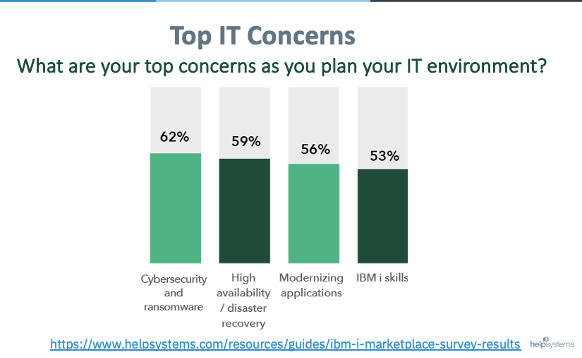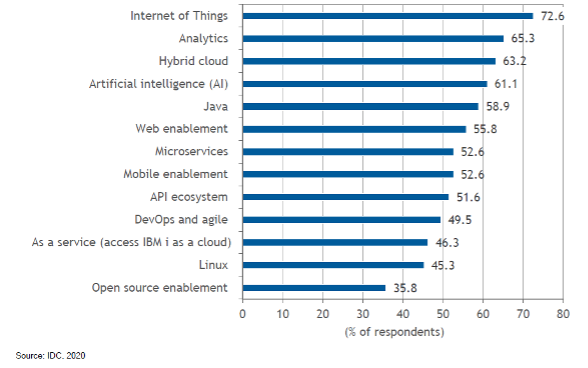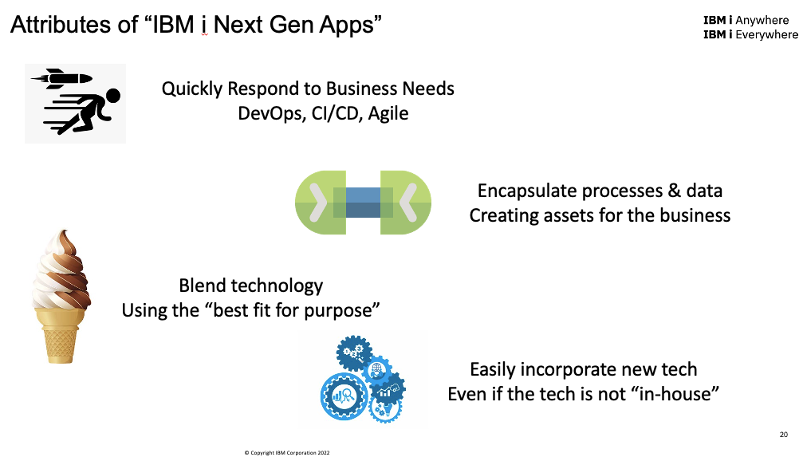IBM i Next Gen Apps: The Modernization Approach
The first cornerstone of IBM i strategy is to provide solution developers with everything they need to be successful. The solution developers we serve include both Independent Software Vendors (ISVs) and the programming teams who create software for specific customers—whether as employees of those customers, or as independent contractors and consultants.
Of the thousands of ISVs who have software which runs on IBM i, many take advantage of its integrated capabilities, and its support for modern development languages and processes—and these ISVs produce modern software which competes well in the marketplace. In fact, there are many IBM i customers who do not need programming staff of their own, because the combination of ISV software and IBM i does everything they need.
Still, there are tens of thousands of clients who have software developed or customized for them, and many of these have taken advantage of modern RPG, open-source languages, services-based architecture and DevOps approaches.
The Need for Modernization
However, despite the fact that many have taken these steps, many more have not. For years, “modernizing” has been one of the top concerns in the IBM i marketplace. This is evident to anyone who has worked with IBM i, is demonstrated by the healthy business done by various modernization vendors and consultants in the IBM i ecosystem, and is documented each year by the 2022 HelpSystems survey (see Figure 1 for a visualization of some of the results).

What Modernization Is Happening?
While I realize some customers are just standing still, and others are depending on their ISVs to do modernization, there are many customers who have done significant modernization projects over the past couple years, and just as many who are doing them now.
So, what are they doing? So many things!
I’m including here a graph from a good study which was done by IDC on behalf of Rocket Software on the benefits of modernizing IBM Z and IBM i (see Figure 2).[1] Let’s take a look and then I’ll make a couple points.

I use this chart to make many points—it’s great to have real data to back up what I see so frequently when I work with clients. I’ll make three of them which relate to the topic I’ll get to next: IBM i Next Gen Apps.
- Modernization leaves key, critical business processing on IBM i, while adding the value of modern technology! This is crucial. Staying on IBM i is universally more beneficial than moving off of it (which the IDC study also shows, through survey data) and it costs less, with more stability and less risk.
- Modernization may include user interfaces, but that’s certainly not the only project—and not even the most common! So, if your business has a need to do something modern with data (analytics) or sensors and robotics (IoT) or APIs/services/cloud, there are many other IBM i customers doing the same. By doing those projects, they are solidifying the value of their IBM i applications in their organizations for the future.
- Most IBM i modernization projects have multiple aspects to them. If you incorporate IoT devices into traditional RPG/SQL/COBOL/Java workflows, you probably also use open source on IBM i, because those devices tend to be driven by open software which can run easily on IBM i. If you’re doing web or mobile enablement for your interfaces, you’re probably also looking at incorporating web/cloud services and/or visualizations of your data through analytics of Db2 data.
OK, so there’s a lot of modernization going on. But it’s been going on a long time. So, a natural question is “Why?” Why is modernization still a need?
There are two basic answers to that question:
- Modernization is a continuous activity, and a journey, not a single task with a single destination
- Some applications, and the organizations which use them, are anchored to old technology. They have trouble seeing a path to modernization which seems both valuable and viable, and their business truly has requirements to adopt modern technology.
No matter which of those situations you find yourself in, frequently your next question is “How do we proceed?”
In the past two years, we’ve started communicating a strategy and an approach we’ve dubbed “IBM i Next Gen Apps.” To best describe it, I’ll lay out the attributes of a “modern” application, and the “modern” approach to developing it.
IBM i Next Gen Apps: Attributes
An IBM i Next Gen App:
- Quickly responds to business needs—typically by using a DevOps approach, CI/CD (methods and tools, and Agile development processes
- There are many tools which can help developers achieve this attribute, and seemingly endless words written about the processes, but at a high level, the problem being addressed is this: business needs change frequently, and a modern application developer needs to be able to recognize a new business requirement and quickly bring a valuable answer to production.
- Encapsulates processes and data, creating assets for the business—typically by creating modular programs or simple SQL programs, and wrapping them as services
- Again, many approaches exist to accomplish this, some included in the IBM i OS itself, and in the Rational tools which have been developed alongside it. This idea is an extension of the long-taught value of modularity, enhanced with the modern value of providing services and/or APIs which can be consumed—and sometimes charged for—in a “cloud-like” way.
- Blends technology, using the “best fit for purpose”—particularly in the programming languages used in the solution
- This often materializes as developing parts of an application suite using modern forms of traditional languages such as RPG, COBOL, SQL, C/C++ and Java with open languages such as JavaScript, PHP and many more. The former set of languages were often built to implement business transactions, and so they are the best fit for that purpose, while the latter set of languages are designed with modern user interfaces and services in mind. Still, it’s not just the programming languages which need to be “blended.” Development and deployment processes and tools often need to be blended as well.
- Easily incorporates new technology, even if the tech is not “in-house”
- This requires a mindset change for many shops. Cloud services exist, inside and outside the enterprise, which can make it much easier to satisfy a business requirement. Additionally, there are libraries of open-source code which can be seamlessly implemented on IBM i without the porting or coding effort one might have expected a decade or more in the past.
I’ve spoken about the “IBM i Next Gen Apps” approach many times over the past two years, and I’ve used the following image (Figure 3) to summarize the approach.

The attributes of an IBM i Next Gen App do not all have to be achieved at once. In fact, selecting one attribute to focus on is often a good place to start, but as you do, if you keep the others in mind, you are likely to find synergy (and business value) by taking multiple attributes into account.
Now, we realize that this approach is not a “step-by-step, follow this and everything is easy” template. Still, based on the experiences we’ve witnessed in many customer and ISV modernization and digital transformation projects, we strongly believe that no matter what modernization project you undertake, you will be most successful if you take a big picture view—a strategic view—with your approach.
While the “IBM i Next Gen Apps” approach is not the only way to look at modernization, we do think it’s well-founded, and it’s an abstraction which describes the approach we’ve seen be successful with many tools, vendors and projects.
And, very importantly, we plan to do more to support this approach as time goes on. Stay tuned!
Until next time—be well, and do great things!